Croatian vs Hawaiian Community Comparison
COMPARE
Croatian
Hawaiian
Social Comparison
Social Comparison
Croatians
Hawaiians
8,930
SOCIAL INDEX
86.8/ 100
SOCIAL RATING
37th/ 347
SOCIAL RANK
3,537
SOCIAL INDEX
32.9/ 100
SOCIAL RATING
218th/ 347
SOCIAL RANK
Hawaiian Integration in Croatian Communities
The statistical analysis conducted on geographies consisting of 254,725,453 people shows a substantial positive correlation between the proportion of Hawaiians within Croatian communities in the United States with a correlation coefficient (R) of 0.598. On average, for every 1% (one percent) increase in Croatians within a typical geography, there is an increase of 0.380% in Hawaiians. To illustrate, in a geography comprising of 100,000 individuals, a rise of 1,000 Croatians corresponds to an increase of 380.0 Hawaiians.
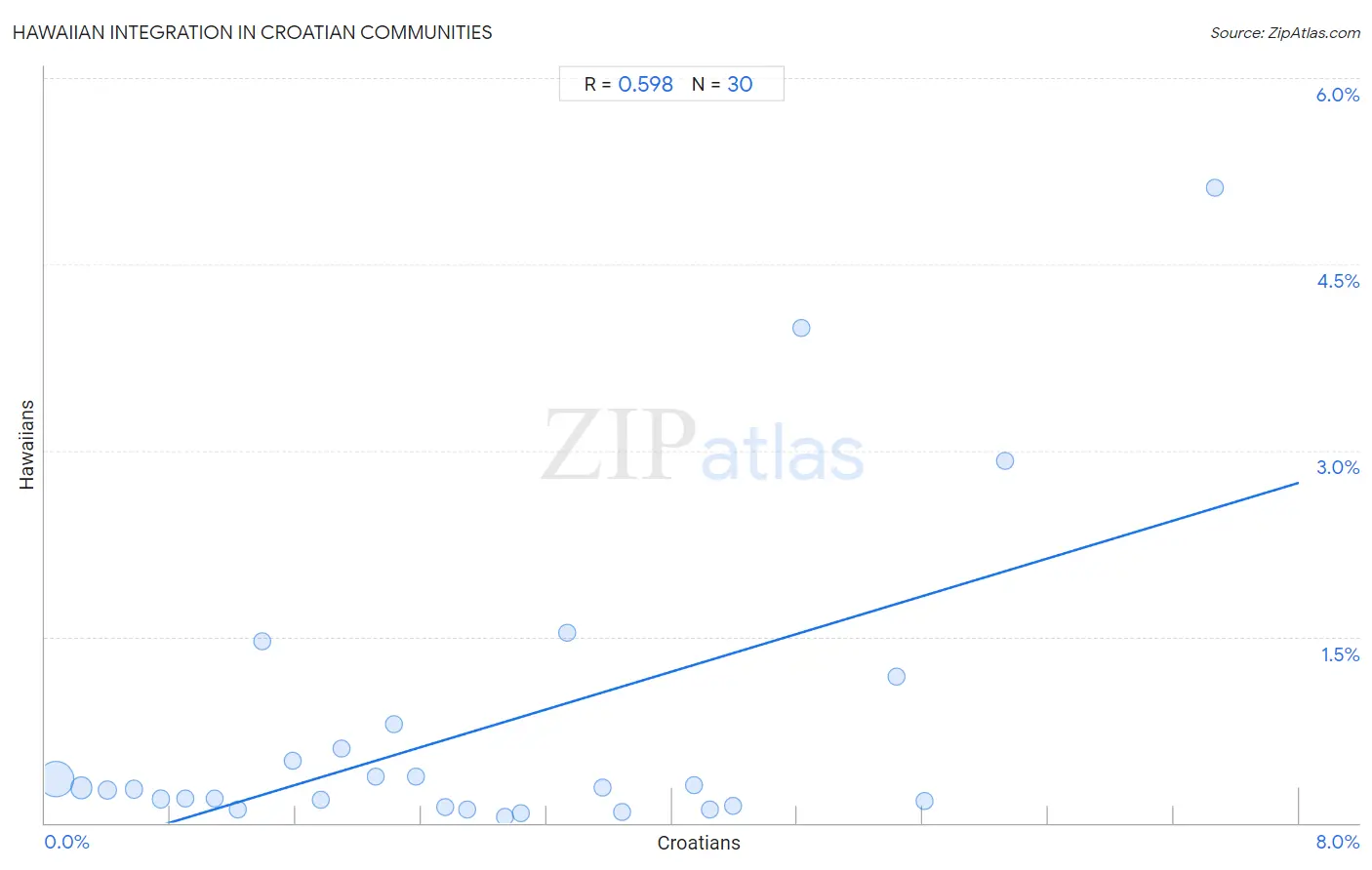
Croatian vs Hawaiian Income
When considering income, the most significant differences between Croatian and Hawaiian communities in the United States are seen in per capita income ($47,742 compared to $39,403, a difference of 21.2%), median male earnings ($59,715 compared to $50,488, a difference of 18.3%), and wage/income gap (29.0% compared to 24.9%, a difference of 16.5%). Conversely, both communities are more comparable in terms of householder income over 65 years ($63,225 compared to $64,920, a difference of 2.7%), householder income under 25 years ($51,662 compared to $53,078, a difference of 2.7%), and median household income ($90,685 compared to $84,729, a difference of 7.0%).

| Income Metric | Croatian | Hawaiian |
| Per Capita Income | Exceptional $47,742 | Tragic $39,403 |
| Median Family Income | Exceptional $111,370 | Poor $98,869 |
| Median Household Income | Exceptional $90,685 | Average $84,729 |
| Median Earnings | Exceptional $49,724 | Tragic $43,673 |
| Median Male Earnings | Exceptional $59,715 | Tragic $50,488 |
| Median Female Earnings | Exceptional $40,993 | Tragic $37,497 |
| Householder Age | Under 25 years | Fair $51,662 | Excellent $53,078 |
| Householder Age | 25 - 44 years | Exceptional $102,414 | Poor $90,722 |
| Householder Age | 45 - 64 years | Exceptional $108,383 | Fair $98,778 |
| Householder Age | Over 65 years | Exceptional $63,225 | Exceptional $64,920 |
| Wage/Income Gap | Tragic 29.0% | Excellent 24.9% |
Croatian vs Hawaiian Poverty
When considering poverty, the most significant differences between Croatian and Hawaiian communities in the United States are seen in receiving food stamps (9.6% compared to 12.9%, a difference of 34.7%), married-couple family poverty (3.9% compared to 5.1%, a difference of 30.6%), and family poverty (7.3% compared to 9.0%, a difference of 23.4%). Conversely, both communities are more comparable in terms of female poverty among 18-24 year olds (19.0% compared to 18.7%, a difference of 1.2%), single male poverty (12.8% compared to 12.6%, a difference of 1.5%), and single mother poverty (28.2% compared to 29.2%, a difference of 3.7%).
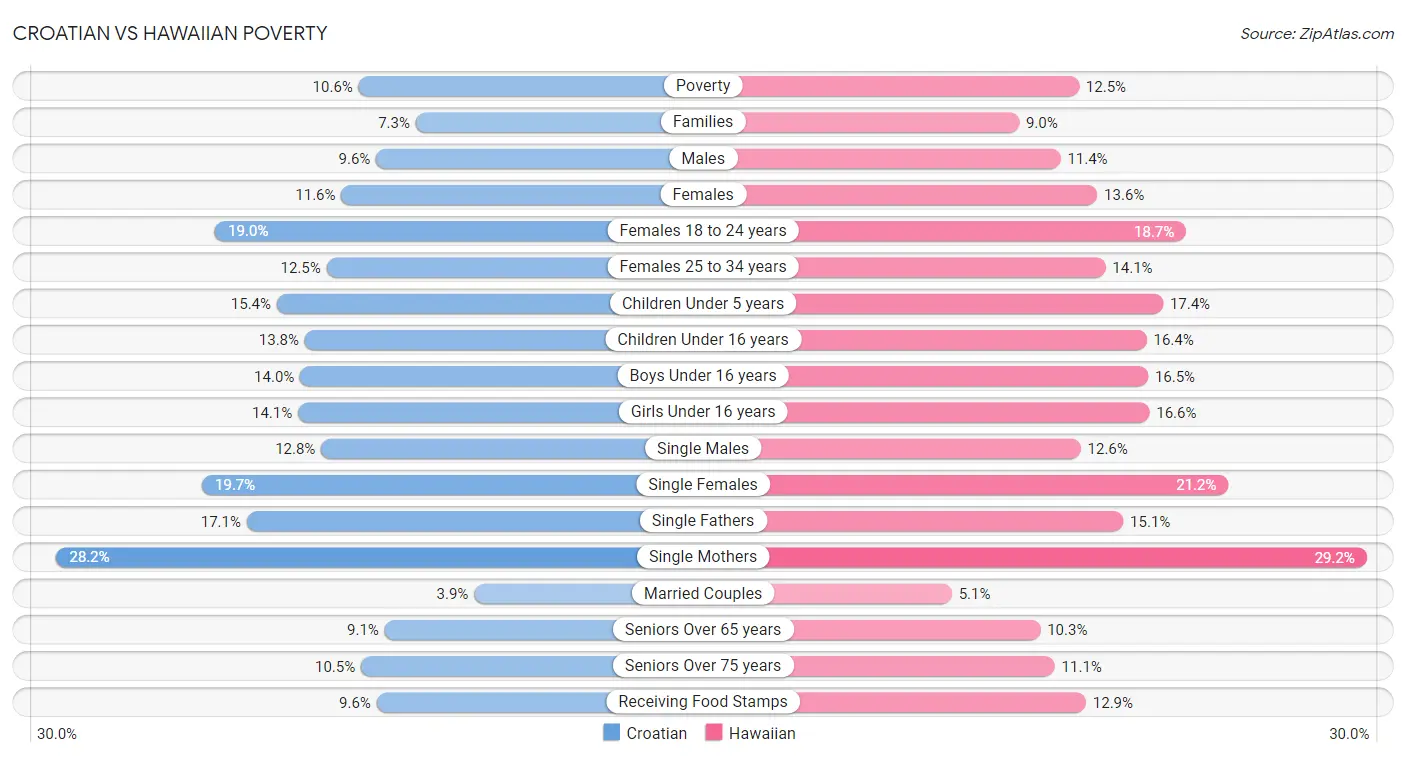
| Poverty Metric | Croatian | Hawaiian |
| Poverty | Exceptional 10.6% | Fair 12.5% |
| Families | Exceptional 7.3% | Average 9.0% |
| Males | Exceptional 9.6% | Fair 11.4% |
| Females | Exceptional 11.6% | Fair 13.6% |
| Females 18 to 24 years | Exceptional 19.0% | Exceptional 18.7% |
| Females 25 to 34 years | Exceptional 12.5% | Poor 14.1% |
| Children Under 5 years | Exceptional 15.4% | Average 17.4% |
| Children Under 16 years | Exceptional 13.8% | Fair 16.4% |
| Boys Under 16 years | Exceptional 14.0% | Average 16.5% |
| Girls Under 16 years | Exceptional 14.1% | Average 16.6% |
| Single Males | Average 12.8% | Good 12.6% |
| Single Females | Exceptional 19.7% | Fair 21.2% |
| Single Fathers | Tragic 17.1% | Exceptional 15.1% |
| Single Mothers | Exceptional 28.2% | Average 29.2% |
| Married Couples | Exceptional 3.9% | Good 5.1% |
| Seniors Over 65 years | Exceptional 9.1% | Exceptional 10.3% |
| Seniors Over 75 years | Exceptional 10.5% | Exceptional 11.1% |
| Receiving Food Stamps | Exceptional 9.6% | Tragic 12.9% |
Croatian vs Hawaiian Unemployment
When considering unemployment, the most significant differences between Croatian and Hawaiian communities in the United States are seen in unemployment among ages 35 to 44 years (4.4% compared to 5.3%, a difference of 21.2%), unemployment (4.8% compared to 5.5%, a difference of 15.4%), and male unemployment (4.9% compared to 5.7%, a difference of 15.0%). Conversely, both communities are more comparable in terms of unemployment among ages 60 to 64 years (4.6% compared to 4.6%, a difference of 0.24%), unemployment among seniors over 75 years (9.6% compared to 9.3%, a difference of 3.5%), and unemployment among ages 25 to 29 years (6.4% compared to 6.8%, a difference of 5.7%).
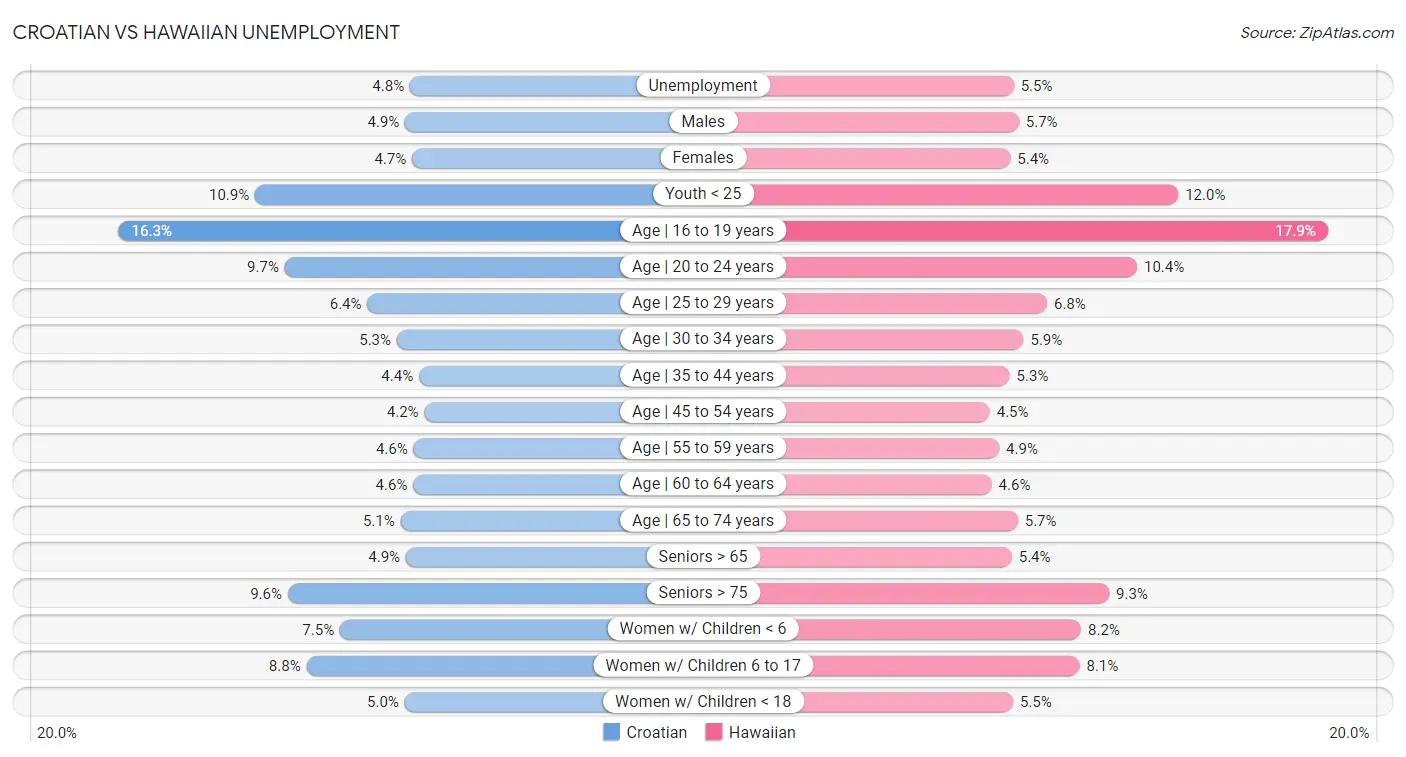
| Unemployment Metric | Croatian | Hawaiian |
| Unemployment | Exceptional 4.8% | Tragic 5.5% |
| Males | Exceptional 4.9% | Tragic 5.7% |
| Females | Exceptional 4.7% | Fair 5.4% |
| Youth < 25 | Exceptional 10.9% | Tragic 12.0% |
| Age | 16 to 19 years | Exceptional 16.3% | Poor 17.9% |
| Age | 20 to 24 years | Exceptional 9.7% | Fair 10.4% |
| Age | 25 to 29 years | Excellent 6.4% | Poor 6.8% |
| Age | 30 to 34 years | Excellent 5.3% | Tragic 5.9% |
| Age | 35 to 44 years | Exceptional 4.4% | Tragic 5.3% |
| Age | 45 to 54 years | Exceptional 4.2% | Fair 4.5% |
| Age | 55 to 59 years | Exceptional 4.6% | Poor 4.9% |
| Age | 60 to 64 years | Exceptional 4.6% | Exceptional 4.6% |
| Age | 65 to 74 years | Exceptional 5.1% | Tragic 5.7% |
| Seniors > 65 | Exceptional 4.9% | Tragic 5.4% |
| Seniors > 75 | Tragic 9.6% | Tragic 9.3% |
| Women w/ Children < 6 | Good 7.5% | Tragic 8.2% |
| Women w/ Children 6 to 17 | Good 8.8% | Exceptional 8.1% |
| Women w/ Children < 18 | Exceptional 5.0% | Average 5.5% |
Croatian vs Hawaiian Labor Participation
When considering labor participation, the most significant differences between Croatian and Hawaiian communities in the United States are seen in in labor force | age 16-19 (41.1% compared to 38.4%, a difference of 7.1%), in labor force | age 25-29 (85.8% compared to 83.0%, a difference of 3.4%), and in labor force | age 30-34 (85.6% compared to 83.0%, a difference of 3.2%). Conversely, both communities are more comparable in terms of in labor force | age > 16 (64.7% compared to 64.7%, a difference of 0.020%), in labor force | age 20-24 (77.2% compared to 77.0%, a difference of 0.22%), and in labor force | age 20-64 (80.1% compared to 78.7%, a difference of 1.8%).

| Labor Participation Metric | Croatian | Hawaiian |
| In Labor Force | Age > 16 | Tragic 64.7% | Tragic 64.7% |
| In Labor Force | Age 20-64 | Exceptional 80.1% | Tragic 78.7% |
| In Labor Force | Age 16-19 | Exceptional 41.1% | Exceptional 38.4% |
| In Labor Force | Age 20-24 | Exceptional 77.2% | Exceptional 77.0% |
| In Labor Force | Age 25-29 | Exceptional 85.8% | Tragic 83.0% |
| In Labor Force | Age 30-34 | Exceptional 85.6% | Tragic 83.0% |
| In Labor Force | Age 35-44 | Exceptional 85.2% | Tragic 83.2% |
| In Labor Force | Age 45-54 | Exceptional 83.6% | Tragic 81.5% |
Croatian vs Hawaiian Family Structure
When considering family structure, the most significant differences between Croatian and Hawaiian communities in the United States are seen in single father households (2.1% compared to 2.7%, a difference of 25.2%), single mother households (5.5% compared to 6.6%, a difference of 20.9%), and births to unmarried women (30.2% compared to 33.2%, a difference of 10.1%). Conversely, both communities are more comparable in terms of divorced or separated (11.9% compared to 12.1%, a difference of 1.3%), married-couple households (48.5% compared to 47.8%, a difference of 1.4%), and currently married (48.9% compared to 46.6%, a difference of 4.9%).

| Family Structure Metric | Croatian | Hawaiian |
| Family Households | Tragic 63.8% | Exceptional 67.4% |
| Family Households with Children | Tragic 26.4% | Exceptional 28.7% |
| Married-couple Households | Exceptional 48.5% | Exceptional 47.8% |
| Average Family Size | Tragic 3.10 | Exceptional 3.41 |
| Single Father Households | Exceptional 2.1% | Tragic 2.7% |
| Single Mother Households | Exceptional 5.5% | Poor 6.6% |
| Currently Married | Exceptional 48.9% | Average 46.6% |
| Divorced or Separated | Excellent 11.9% | Average 12.1% |
| Births to Unmarried Women | Excellent 30.2% | Poor 33.2% |
Croatian vs Hawaiian Vehicle Availability
When considering vehicle availability, the most significant differences between Croatian and Hawaiian communities in the United States are seen in 4 or more vehicles in household (6.5% compared to 8.9%, a difference of 36.9%), 3 or more vehicles in household (20.6% compared to 24.3%, a difference of 17.9%), and 2 or more vehicles in household (58.6% compared to 60.4%, a difference of 3.1%). Conversely, both communities are more comparable in terms of 1 or more vehicles in household (91.9% compared to 92.0%, a difference of 0.21%), no vehicles in household (8.3% compared to 8.0%, a difference of 2.7%), and 2 or more vehicles in household (58.6% compared to 60.4%, a difference of 3.1%).

| Vehicle Availability Metric | Croatian | Hawaiian |
| No Vehicles Available | Exceptional 8.3% | Exceptional 8.0% |
| 1+ Vehicles Available | Exceptional 91.9% | Exceptional 92.0% |
| 2+ Vehicles Available | Exceptional 58.6% | Exceptional 60.4% |
| 3+ Vehicles Available | Exceptional 20.6% | Exceptional 24.3% |
| 4+ Vehicles Available | Good 6.5% | Exceptional 8.9% |
Croatian vs Hawaiian Education Level
When considering education level, the most significant differences between Croatian and Hawaiian communities in the United States are seen in no schooling completed (1.5% compared to 2.2%, a difference of 48.0%), professional degree (4.9% compared to 3.4%, a difference of 42.8%), and master's degree (16.4% compared to 11.6%, a difference of 41.4%). Conversely, both communities are more comparable in terms of nursery school (98.6% compared to 97.9%, a difference of 0.71%), kindergarten (98.6% compared to 97.9%, a difference of 0.71%), and 1st grade (98.6% compared to 97.9%, a difference of 0.72%).
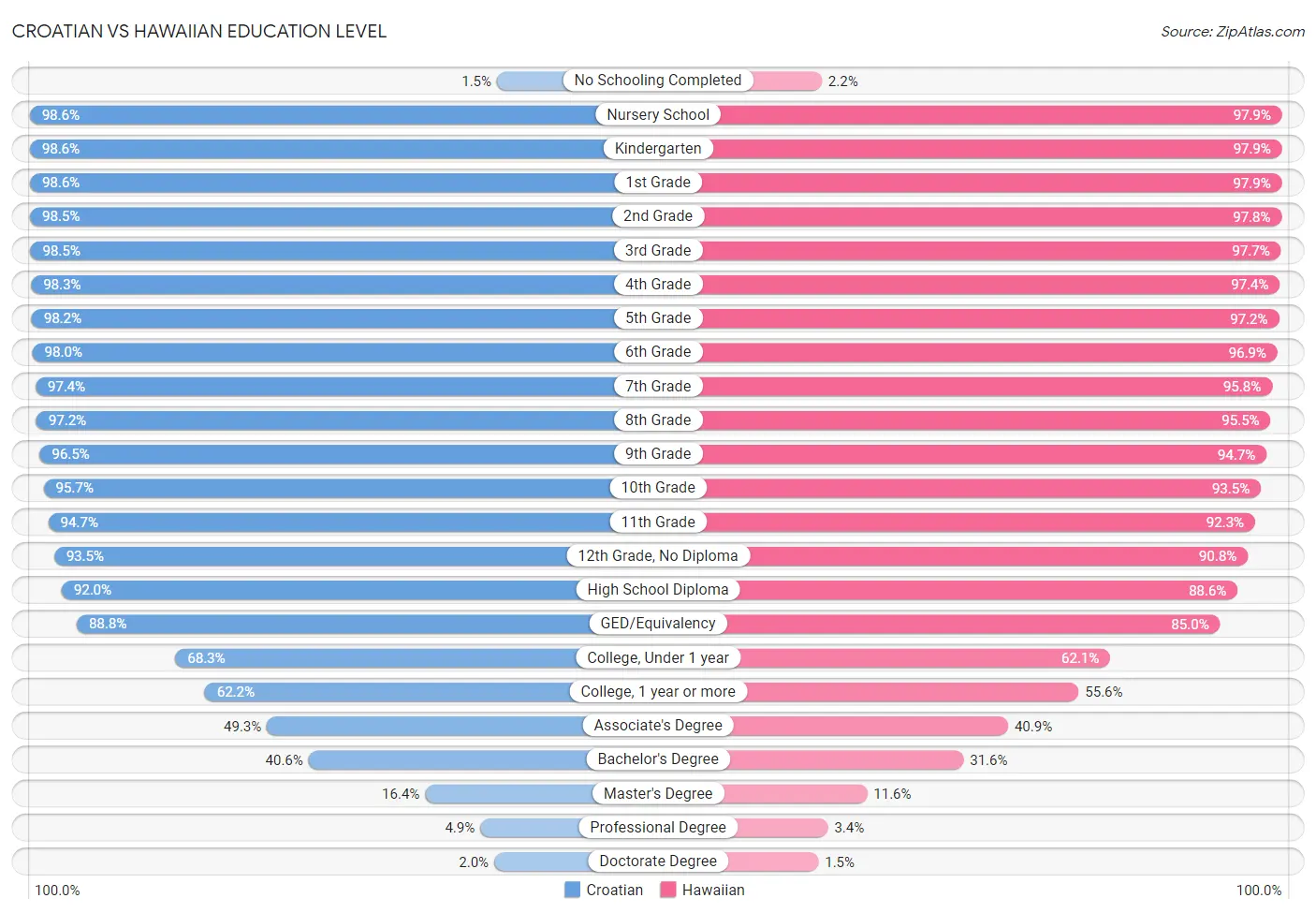
| Education Level Metric | Croatian | Hawaiian |
| No Schooling Completed | Exceptional 1.5% | Fair 2.2% |
| Nursery School | Exceptional 98.6% | Fair 97.9% |
| Kindergarten | Exceptional 98.6% | Fair 97.9% |
| 1st Grade | Exceptional 98.6% | Fair 97.9% |
| 2nd Grade | Exceptional 98.5% | Fair 97.8% |
| 3rd Grade | Exceptional 98.5% | Fair 97.7% |
| 4th Grade | Exceptional 98.3% | Fair 97.4% |
| 5th Grade | Exceptional 98.2% | Fair 97.2% |
| 6th Grade | Exceptional 98.0% | Fair 96.9% |
| 7th Grade | Exceptional 97.4% | Poor 95.8% |
| 8th Grade | Exceptional 97.2% | Poor 95.5% |
| 9th Grade | Exceptional 96.5% | Fair 94.7% |
| 10th Grade | Exceptional 95.7% | Fair 93.5% |
| 11th Grade | Exceptional 94.7% | Fair 92.3% |
| 12th Grade, No Diploma | Exceptional 93.5% | Poor 90.8% |
| High School Diploma | Exceptional 92.0% | Poor 88.6% |
| GED/Equivalency | Exceptional 88.8% | Poor 85.0% |
| College, Under 1 year | Exceptional 68.3% | Tragic 62.1% |
| College, 1 year or more | Exceptional 62.2% | Tragic 55.6% |
| Associate's Degree | Exceptional 49.3% | Tragic 40.9% |
| Bachelor's Degree | Exceptional 40.6% | Tragic 31.6% |
| Master's Degree | Exceptional 16.4% | Tragic 11.6% |
| Professional Degree | Exceptional 4.9% | Tragic 3.4% |
| Doctorate Degree | Exceptional 2.0% | Tragic 1.5% |
Croatian vs Hawaiian Disability
When considering disability, the most significant differences between Croatian and Hawaiian communities in the United States are seen in disability age under 5 (1.5% compared to 1.2%, a difference of 26.3%), disability age 65 to 74 (21.8% compared to 25.5%, a difference of 17.1%), and disability age 35 to 64 (11.0% compared to 12.3%, a difference of 11.7%). Conversely, both communities are more comparable in terms of hearing disability (3.4% compared to 3.5%, a difference of 2.0%), female disability (12.4% compared to 12.7%, a difference of 2.7%), and disability age 5 to 17 (5.7% compared to 5.5%, a difference of 3.1%).
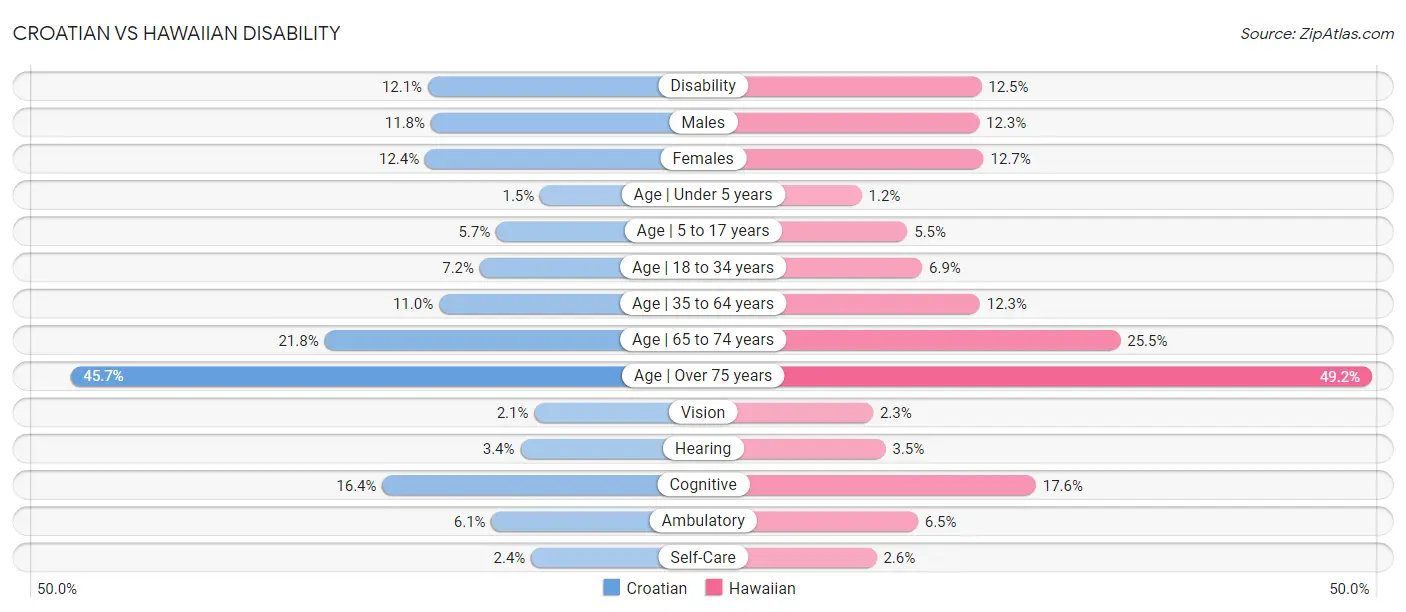
| Disability Metric | Croatian | Hawaiian |
| Disability | Tragic 12.1% | Tragic 12.5% |
| Males | Tragic 11.8% | Tragic 12.3% |
| Females | Fair 12.4% | Tragic 12.7% |
| Age | Under 5 years | Tragic 1.5% | Good 1.2% |
| Age | 5 to 17 years | Fair 5.7% | Good 5.5% |
| Age | 18 to 34 years | Tragic 7.2% | Tragic 6.9% |
| Age | 35 to 64 years | Good 11.0% | Tragic 12.3% |
| Age | 65 to 74 years | Exceptional 21.8% | Tragic 25.5% |
| Age | Over 75 years | Exceptional 45.7% | Tragic 49.2% |
| Vision | Exceptional 2.1% | Tragic 2.3% |
| Hearing | Tragic 3.4% | Tragic 3.5% |
| Cognitive | Exceptional 16.4% | Tragic 17.6% |
| Ambulatory | Average 6.1% | Tragic 6.5% |
| Self-Care | Exceptional 2.4% | Tragic 2.6% |